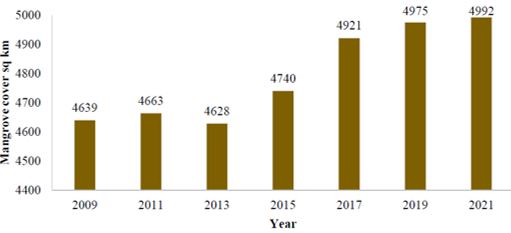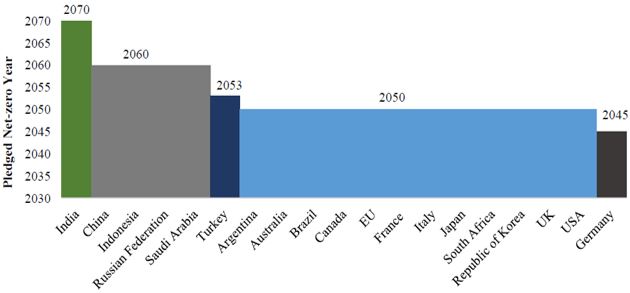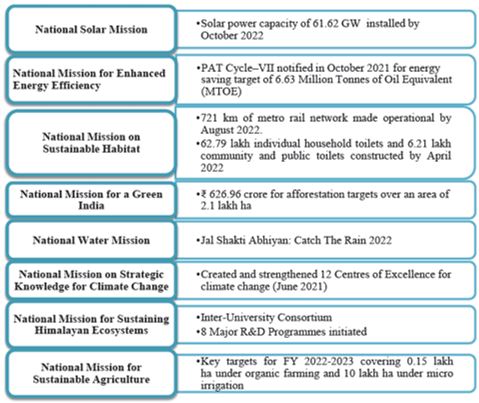Climate justice and living in a way that is good for the environment are mentioned in the vision as ways to protect the weak and poor from the bad effects of climate change. In line with this goal, the amount of power that doesn't come from fossil fuels has grown quickly over time. Non-fossil sources, such as large hydro, are expected to make up about 40.4% of the total installed electrical capacity on September 30, 2022. This is up from 27.3% in 2014–15. The percentage of installed electricity capacity made up of solar and wind energy has significantly increased during this time, rising from 8.9% in 2014–15 to 25.1% in 2022–23 (April–Sept).
FOREST AND TREE COVER CONDITIONS
The addition of 2.5 billion to 3.0 billion metric tonnes of carbon sinks through increased forest and tree cover by 2030 is one of India's NDC's three quantifiable targets. For the past 15 years, India's forest and tree cover have steadily and gradually increased.
The country is third in the world in terms of the average net gain in forest area each year between 2010 and 2020. Most of this change is because the federal and state governments have strong structures and policies that have helped and protected forests. The most significant programmes include the Green India Mission (GIM), Compensatory Afforestation Fund Management and Planning Authority (CAMPA), National Afforestation Programme (NAP), Green Highway Policy 2015, Policy for Enhancing Urban Greens, National Agro-forestry Policy, and Sub-Mission on Agro-forestry (SMAF), among others.
ECOSYSTEM PRESERVATION ADAPTATION STRATEGY
Ecosystems do a lot more than just provide services like cultural, spiritual, or tourist attractions. They also store carbon, protect coastal zones, and improve water quality.Wetlands act as natural barriers to drought, floods, and tropical cyclones. Wetlands can act as sponges, holding onto peak rainfall and slowly releasing it during the dry season.
Floods in Chennai, India, in December 2015 and the Kashmir Valley, India, in September 2014 serve as reminders of how wetland devastation can put lives in danger. One of the earliest intergovernmental agreements signed by signatory nations to protect the ecological integrity of their globally significant wetlands is the Ramsar Convention, which was established on February 2, 1971.
Declared wetlands are protected as Ramsar areas. 13.3 lakh acres are covered by India's 75 Ramsar sites, 49 of which have been added in the past eight years. For coastal communities, mangroves and coastal wetlands act as the first line of defence against rising storm surges, flooding, and storms.
A recent study found that by 2070, certain mangrove species in India's Chilika and Sundarbans on the east coast and Dwarka and Porbandar on the west coast are likely to decrease and move inland as a result of a decline in suitable habitats as a result of precipitation and sea level changes.
In order to protect and keep mangroves alive, the government has taken both legal and public relations steps. 'Conservation and Management of Mangroves and Coral Reefs' is the focus of the National Coastal Mission Programme, which is now being carried out. The Coastal Regulation Zone (CRZ) Notification (2019) is used to implement regulations under the Environment (Protection) Act of 1986, the Wild Life (Protection) Act of 1972, the Indian Forest Act of 1927, and the Biological Diversity Act of 2002, as they have been amended from time to time. According to ISFR 2021, the country's mangrove cover rose by 364 sq. km. in 2021 compared to 2013.

Figure 3: Increasing Mangrove cover in India
RIVER RESTORATION AND CONSERVATION
The 5Ps — people, policy, plan, programme, and project — are being mapped and converged by the government. Through the Central Sector Scheme of Namami Gange for the River Ganga and its tributaries and the Centrally Sponsored Scheme of the National River Conservation Plan (NRCP) for other rivers, it has been assisting the States and Union Territories (UTs) in their efforts to reduce pollution in identified polluted stretches of the country's rivers.
Additionally, the Indian Council of Forestry Research and Education (ICFRE), Dehradun, in collaboration with the state forest departments and other line departments, has produced Detailed Project Reports (DPR) for the rejuvenation of 13 key rivers. These DPRs include projects like planting trees along riverbanks to increase green cover, recharging the groundwater table, capturing carbon dioxide, treating catchment areas, ecological restoration, preserving moisture, improving livelihoods, generating money, etc.
THE PRESERVATION AND PROTECTION OF WILDLIFE
India has a long history of trying to protect wildlife and a lot of different kinds of wildlife.


 ©
© 

